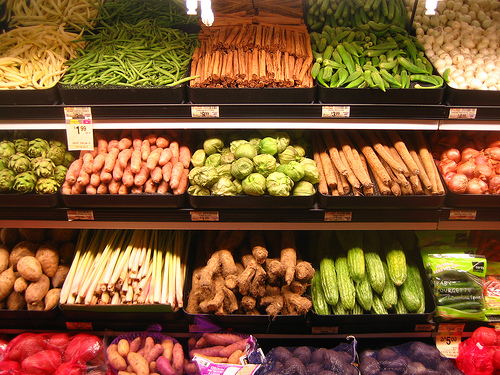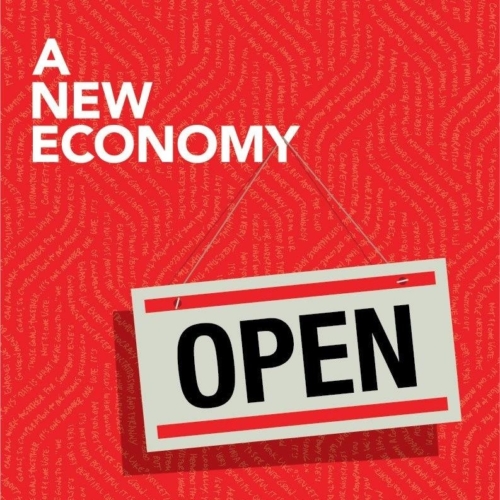Death to the supermarket
 Uniform, flawless produce requires a heartbreaking amount of food waste. (Photo by rick via Flickr)
Uniform, flawless produce requires a heartbreaking amount of food waste. (Photo by rick via Flickr)If we’re to feed the world delicious, nutritious food and halt climate change, we have to kill the supermarket.
There are many reasons why I suggest this enormous beast be culled. It thrives on the unsustainable industrial agriculture model of large-scale, monocrop food production, where food is not grown for taste or nutrition. It’s then shipped long distances, so you can eat lettuce in Vancouver in January. Even if garlic is grown in your region, you’re served up the garlic from China instead.
The produce section is a sterile place devoid of scent (the first sense to get us salivating), where the fruits and vegetables are uniform, barely ripe (if at all) and virtually flawless. It’s no wonder children don’t know their food grows in the ground or on a vine: the produce is so unnatural, it hardly seems a product of nature. Its sprawling, dizzying vastness is a maze that encourages overconsumption and takes up excess land to, among other things, allow for extra-wide shopping carts. It makes buying junk food more appealing than buying produce through a combination of store positioning, packaging and price, and this leads to disease.
I could go on; the reason I’m going to focus on here, however, is its massive — and one could suggest criminal — contribution to food waste.
Last week, I watched Valentin Thurn’s excellent documentary Taste the Waste at the Vancouver International Film Festival.
The film interviews interesting people in Europe, Japan and the US who are playing a positive role in creating change. They show and tell us the miserable truth about what happens to the food we grow that doesn’t land on our plates. Here’s some food for thought to start with — some staggering statistics courtesy of the David Suzuki Foundation:
- Close to half of all food produced worldwide is wasted — discarded in processing, transport, supermarkets and kitchens.
- As much as 30 per cent of food, worth about $48 billion, is thrown away in the US each year. (The average household there throws out about 215 kilograms of food each year — around $600 dollars worth.)
- In Toronto, single-family households discard about 275 kilos of food waste each year (although that city’s expanding composting program captures about 75 per cent of that). That means one in four food purchases still ends up in the garbage. (Toronto taxpayers spend nearly $10 million a year getting rid of food waste that’s not composted.)
- Over 30 percent of fruits and vegetables in North America don’t even make it onto store shelves because they’re not pretty enough for picky consumers.
- About 20 per cent of Canada’s methane emissions (a greenhouse gas that traps more heat in the atmosphere than carbon dioxide) come from landfills.
- When people toss food, all the resources to grow, ship and produce it get chucked, too, including massive volumes of water. In the US alone, the amount of water loss from food waste is like leaving the tap running and pouring 40 trillion litres of water down the drain.
Considering methane is 25 times stronger than carbon dioxide, diverting half of the food we throw out away from landfills would have the same impact on greenhouse gas reduction as taking every second car off the road. Industrial agriculture is so energy-intensive, requiring machinery and petroleum-based fertilizers, that it’s responsible for over one third of the greenhouses gases emitted worldwide.
Along with these losses is all the packaging that goes with the discarded food. Yogurt cups, mesh bags, bottles… Does any of that get retrieved for recycling?
Wasteful business practices
The supermarket can’t predict what will be bought in a day and has to offer variety – oranges, cucumbers, yogurt, bread. (Variety is good, yet they stock very few varieties of fruits and vegetables.) With the need for well-stocked shelves and a constant influx of supply, inevitably what can’t be sold will be tossed, even before its expiry date or before it actually expires. Consumers don’t want to buy products that are about to expire (understandably), and by renewing products quickly on the shelves, the business makes more sales. It’s utterly shocking how much edible food is thrown out from stores because it cannot be sold — and this is after the 30% that never makes it to the shelf.
Rejection
The industrial agriculture-fed supermarket system has to handle large volumes. By design, it requires uniformity, therefore anything too big or too small, or bendy as it is with cucumbers, gets rejected. (Fast food chains require uniformity as well. Thank McDonald’s for starting it.) It’s all handled, processed and judged by computers, machinery and conveyor belts. (The conveyors are very creepy in the film.)
I like buying fruit that others might pass up because it’s too ripe or a little bruised. I’ll happily eat it — chances are, for the quick shop I’m usually making, I’m going to eat it the same day so I want that ripeness. But we’ve been conditioned to want an unnaturally perfect pear, uniform in shape with its fellow pears, uniform in ripeness. I guess we can afford to be picky, and apparently can’t afford not to. Sure, I don’t want to buy a completely mushy peach with a patch of mould on it, but what’s wrong with slight blemishes? It still tastes good — or it should, but that’s a whole other story.
We undervalue our food
Some food waste comes from buying more than is necessary. Supermarkets entice shoppers with deals, like 2-for-1 or large volumes, that encourage us to buy more than we need, and if it doesn’t keep, it goes to waste. Inexpensive food to which most of us have access — because it’s in bulk, poor quality, or highly subsidized like corn or fast food — offers little incentive to prevent food waste, versus expensive food. My 60-something parents recall growing up in working class in the 50s and 60s, pinching pennies and appreciating every meal. As post-war immigrants, they experienced malnutrition first-hand and still to this day are very careful not to waste food. Canadians discard one in four food items they purchase. I feel so disconnected from this fact because I’ve grown up in a home where wasting food is unacceptable.
Just as there’s a general consensus that wasting food is shameful, I think few people would disgree that ending world hunger is a priority. What I didn’t realise is that our food consumption affects prices not just in Canada (or wherever you live) but globally as well. So when we waste food, we have to buy more, and this consumption drives up prices to the point where the impoverished in Africa — a continent that provides food to Europe — can’t afford to eat. It’s not fair that we waste food in our kitchens and supermarkets with hardly a bat of an eyelash, yet there are plenty of hungry people on the streets of Vancouver who would appreciate every edible morcel. I was saddened to learn that the amount of edible food discarded in North America and Europe would feed the hungry — three times over.
Holy carp! How can I prevent food waste?
- Shop at the farmer’s market instead of the supermarket as much as possible. You’ll get fresher food with more variety than supermarkets offer, and you’ll support your local farmer’s business. Find small produce vendors, too. (There are lots in Vancouver.)
- Buy local as much as possible. (This is easier if you also follow the above tip!)
- Only buy what you need. Plan your meals ahead so you know what you need to acquire. Don’t be tempted by deals that will waste your money along with your food.
- When at restaurants, order on the smaller scale. If you’re still hungry, you can order more food. Inquire about the type of container the restaurant uses when you ask to take leftovers home. If it’s not recyclable, make a friendly suggestion to your server or, as I did once, ask for another kind of container that is. If you’re really awesome, you’ll have your own along for those times!
- Save leftovers for lunch or freeze what can’t be eaten within a couple of days. You can also toss leftovers into a soup or frying pan. This goes for grains and sauces, too.
- Don’t be too picky, but be realistic: know how fast you’re going to consume fresh produce so you can buy it as ripe as possible without it going bad. Freeze it if you can’t eat it in time. (Banana muffins, anyone?)
- Be conscious of what’s in your fridge. Eat it, cook it, freeze it, share it, give it away. Read these tips on keeping produce fresh and edible at home. Lovefoodhatewaste.com has tips and cheeky photos.
- When all else fails, compost wasted food with the rest of your trimmings. Find out if your municipality collects food scraps.
- Also make sure you buy seafood that comes from well-managed fisheries that avoid overfishing. Half of all fish caught in the North Sea is thrown back overboard dead.
I personally never enjoy shopping at a supermarket. I can’t easily find what I’m looking for; I’m distracted by items I don’t need; the layout, wayfinding and labelling are infuriating; and the atmosphere of the store is sterile and uninviting. Store staff can be hard to track down and checkout clerks are sometimes as impersonal as checkout machines. I’ll gladly pay a little more to shop for good, wholesome food at a small place like Choices or the 4th Avenue Whole Foods (formerly Capers) where I feel welcome instead of overwhelmed; where I’ll have a conversation with a clerk or fellow shopper every so often; where I’ll wander around slowly because I’m enjoying myself. And where I don’t feel so disconnected from nature. I’ll pay a little more, but I won’t waste 1 in 4 items.
Take note of how much food you waste — at home, at work and dining out — and see if you can cut it in half. And as much as possible, avoid the supermarket, for until we see systematic changes, it will continue to waste enough food to break your heart.



